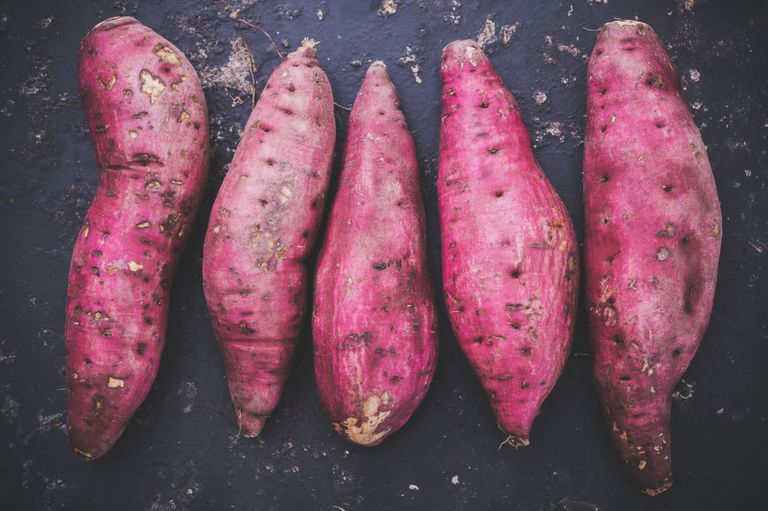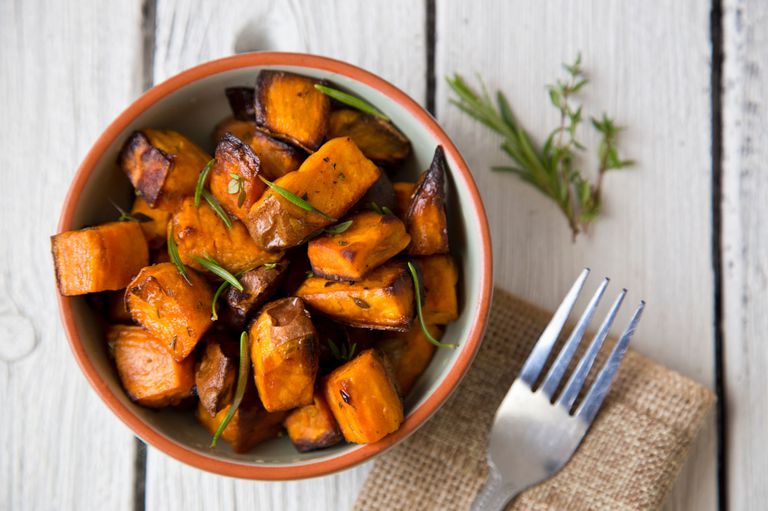They’re sweet, soft, and total nutrition powerhouses. Loaded with vitamins, minerals, fiber, and health-promoting phytonutrients, sweet potatoes are good for you and easy to prepare. They may seem too good to be true, but this colorful root vegetable belongs on your shopping list.
NUTRITION STATS
Serving Size: 1 medium-size sweet potato
- 112 calories
- 26g carbohydrates (8% DV)
- 2g protein
- 0g total fat
- 0g saturated fat
- 4g fiber (15% DV)
- 5g sugar
- 438 mg potassium (12% DV)
- 32mg magnesium (8% DV)
- 39mg calcium (3% DV)
- 0.8mg iron (3% DV)
- 61 mg phosphorus
- 3mg vitamin C (5% DV)
- 0.3mg vitamin B6 (15% DV)
- 18,443 IU vitamin A (386% DV)
HEALTH BENEFITS OF SWEET POTATOES
There’s a reason you find sweet potatoes in every salad shop special. Eating them can lead to:
- Healthy vision: All of that vitamin A helps maintain eyesight.
- Better immunity: Vitamin A also helps with other bodily functions, including cellular communication, growth, and differentiation.
- A sharper mind: Vitamin B6 is an essential coenzyme for cognitive development.
- A stronger heart: Both potassium and magnesium are involved in blood pressure support.
- Lower LDL cholesterol: The fiber can help reduce bad cholesterol and risk of heart disease, obesity, and type 2 diabetes.
ARE SWEET POTATOES BETTER FOR YOU THAN WHITE POTATOES?
While sweet potatoes are significantly higher in vitamin A and slightly higher in fiber, the white potato wins when it comes to potassium and vitamin C content. Both white and sweet potatoes count as nutrient-dense foods. Switch it up and get the benefits of both.
ARE SWEET POTATOES HIGH IN SUGAR?
Nope! They’ve got naturally occurring sugar, but there’s no added sugar in sweet potatoes (unless you’re adding some during cooking). In fact, research shows that sweet potatoes may be an excellent addition to a diabetic diet. It’s a common misconception that diabetics must avoid carbohydrates altogether. What matters is the type of carb and spreading them throughout the day. Sweet potatoes are a low-glycemic food and high in fiber, which means they release and absorb glucose into the bloodstream very slowly, preventing a spike in blood sugar.
ARE SWEET POTATOES THE SAME AS YAMS?
Although many Americans use their names interchangeably, the two vegetables are not related. Yams are almost exclusively grown in Africa and Asia. Look for a cylindrical shape with a black or brown bark-like skin, as well as white, purple, or reddish flesh. They’re drier and starchier than sweet potatoes, and often only found in international supermarkets.
True sweet potatoes are more readily available in U.S. grocery stores. So what’s with the name mix-up? There are two main varieties of sweet potatoes grown in the U.S.: white flesh and orange flesh. Apparently, the orange variety only entered the American market several decades ago. In order to differentiate between the two, producers started selling them as yams. Therefore, the orange sweet potatoes are often mislabeled as yams in stores.

ORANGE, YELLOW, OR PURPLE SWEET POTATOES: WHAT’S THE DIFFERENCE?
Studies show that the different colored sweet potatoes may contain varying levels of phytonutrients, the health-promoting chemicals found in plants. For instance, orange sweet potatoes have the highest levels of beta-carotene, a carotenoid with antioxidant activity. On the other hand, purple sweet potatoes have more anthocyanins, the flavonoid found in blueberries. Anthocyanins also have an antioxidant effect and may support healthy brain function. Bottom line: Including a variety of colors in your diet is the way to go!
CAN YOU O.D. ON VITAMIN A?
While it’s true that excess levels of pre-formed vitamin A from supplements can lead to a toxicity known as hypervitaminosis A, large amounts of pro-vitamin A carotenoids (i.e., those from fruits and veggies) are NOT associated with major adverse side effects. However, eating excessive amounts of beta-carotene rich foods like carrots can cause a harmless condition called carotenemia, which is characterized by yellow pigmentation of the skin.
HOW SHOULD I PREPARE THEM?
There are so many delicious ways to reap the benefits of sweet potatoes! When purchasing, select firm tubers (no soft spots) with smooth skin. Store them loose for up to a week in a cool, dry, and dark place — not the fridge, as this can cause their core to harden and create an unpleasant taste when cooked.
Use the spuds in a variety of recipes, including breakfast dishes, casseroles, and even desserts. We love baking a batch of sweet potatoes for the week and adding them to both sweet and savory meals. Tip: Keep the sweet potato skin on to maximize the fiber content.












